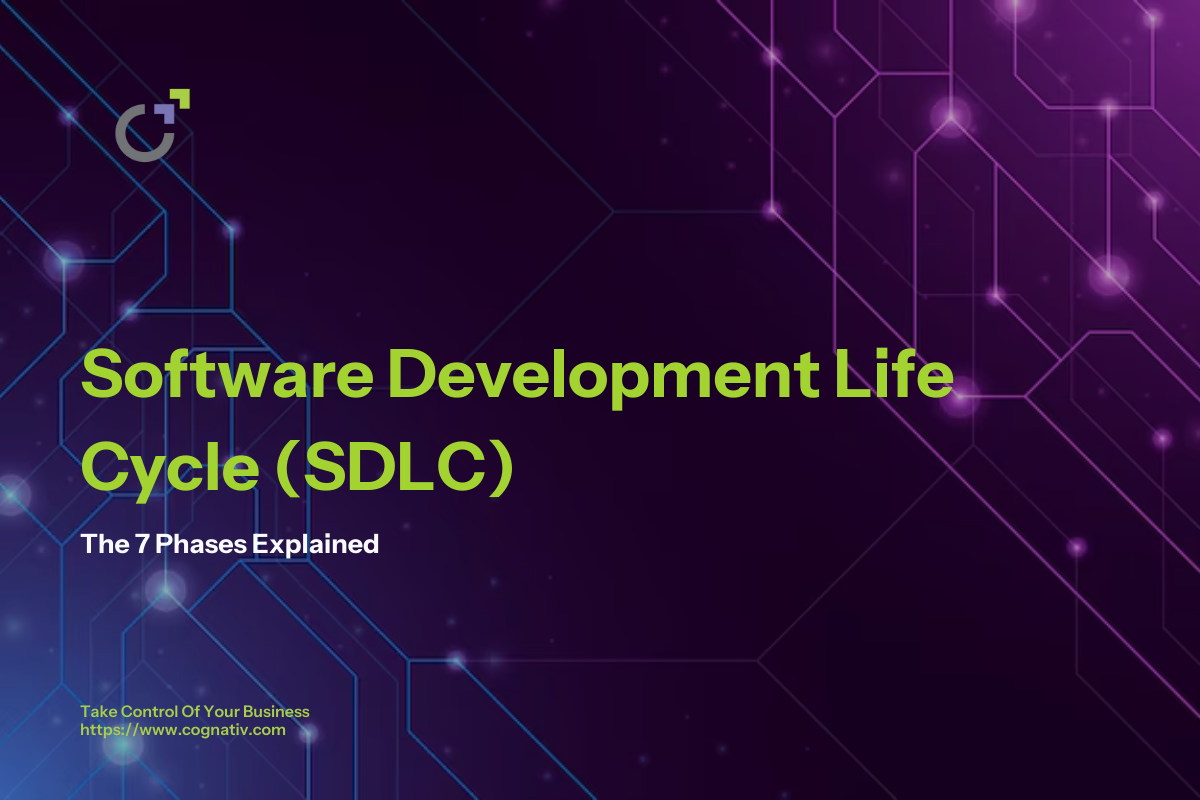Software Development Life Cycle (SDLC): The 7 Phases Explained
The Software Development Life Cycle (SDLC) is a structured process that guides teams through planning, creating, testing, deploying, and maintaining high‑quality software.
Often compared to an architectural blueprint, the SDLC sets up the stages necessary for thorough development and smooth handoffs across a project’s lifespan. Whether you’re developing a small web app or a large enterprise system, understanding the SDLC phases helps ensure clarity of scope, consistent progress, and alignment with user needs. By focusing on the key processes and following best practices, organizations can achieve a more predictable, efficient, and secure software development journey.
In today’s competitive market, it is essential to have a well‑defined SDLC that not only delivers robust software but also integrates modern agile practices, risk management, and continuous improvement techniques. This guide provides a comprehensive overview of the SDLC, breaks down its seven primary phases in detail, and explains how automation and iterative feedback can further enhance the development process.
Table of Contents
- What Is the SDLC?
- Key SDLC Models
- The 7 Phases of the Software Development Life Cycle
- Choosing the Correct Order of SDLC Phases
- Automating SDLC Phases
- Frequently Asked Questions
- Conclusion

What Is the SDLC?
The Software Development Life Cycle is a formal methodology that breaks down the software creation process into distinct phases. Each phase has defined inputs and outputs, ensuring that stakeholders and teams stay aligned on deliverables. Typically, an SDLC aims to produce software that meets requirements with minimal errors and rework, provide a roadmap to measure progress and manage resources, and maintain a consistent approach from concept to maintenance, thereby facilitating transparency and predictability.
This framework is essential because it forces teams to consider every aspect of development—from initial planning and design to deployment and ongoing maintenance—ensuring that nothing is overlooked. Whether the project is small or large, the SDLC acts as a roadmap that guides the team step-by-step and helps prevent scope creep and project delays. In a world where rapid software delivery is critical, adhering to a defined SDLC not only increases the quality of the final product but also reduces overall risk by anticipating issues before they escalate.
By using a structured SDLC, organizations can ensure that their software products are built on a solid foundation, with each stage reinforcing the previous one. This comprehensive approach makes it easier to introduce changes, incorporate user feedback, and continuously improve the product over time.
SDLC as a Formal Methodology
The Software Development Life Cycle (SDLC) is a structured framework that organizes the creation of software into distinct phases. Each phase has specific inputs and outputs, enabling teams and stakeholders to remain aligned on deliverables throughout the project. Typically, an SDLC strives to:
- Produce robust software that meets functional and quality requirements with minimal errors and rework.
- Provide a measurable roadmap to track progress, manage resources effectively, and schedule critical milestones.
- Maintain consistency from concept to maintenance, ensuring transparency and predictability at each stage of development.
By demanding thorough consideration of everything from initial planning to post-release maintenance, the SDLC reduces the chance of overlooked requirements, scope creep, and unforeseen project delays. Even for projects of smaller scope, applying an SDLC helps uphold quality and anticipate potential issues before they escalate. In a fast-paced environment where rapid delivery is vital, this methodology helps teams keep pace while preserving high software standards.
Why the SDLC Matters?
A well-defined SDLC forces teams to think holistically about the product they are building. It compels them to:
- Plan extensively before coding begins, identifying scope, goals, and resources needed.
- Iterate effectively, introducing changes at the right phase based on ongoing feedback.
- Continuously refine the software, making it simpler to adapt to new user needs, regulatory requirements, or market conditions.
Moreover, a formal SDLC is especially beneficial when multiple teams or stakeholders are involved. It ensures each group clearly understands their roles, objectives, and dependencies. By enforcing this step-by-step methodology, organizations foster a shared vision of the project’s trajectory, ultimately delivering software that is both high in quality and aligned with end-user expectations.
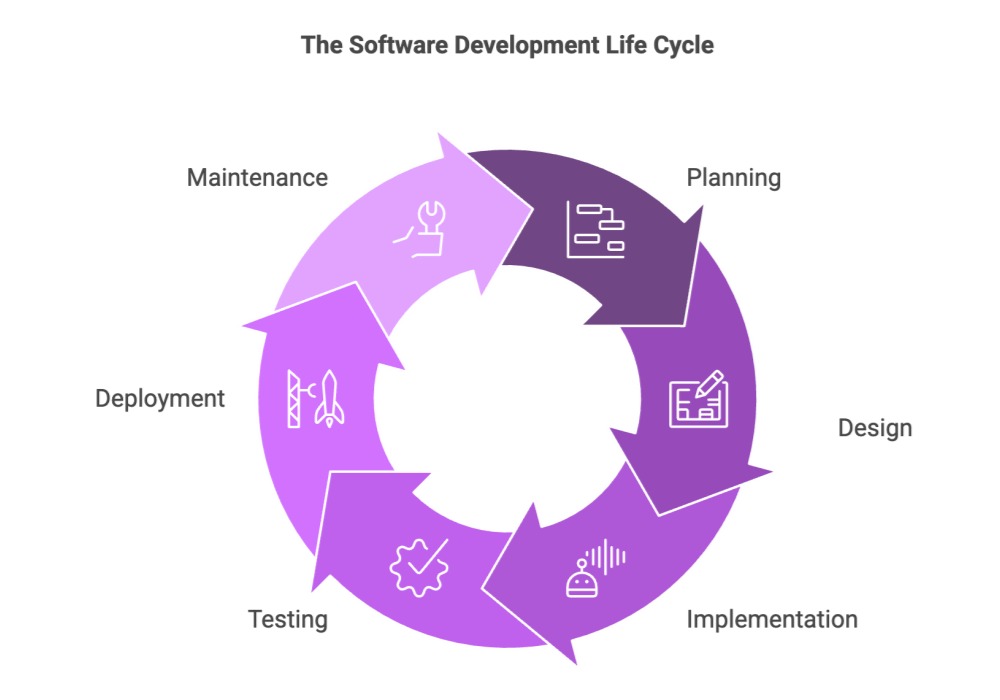

Key SDLC Models
Several SDLC models have been developed over the years, each offering a unique approach to managing the software development process. These models provide frameworks that help teams choose methodologies based on project requirements, risk tolerance, and budget constraints. The most common models include:
- Waterfall Model: A linear, sequential approach where each phase must be completed before moving on to the next. This model is best suited for projects with well-defined requirements and little anticipated change.
- Iterative Model: This model involves repeated cycles (iterations) of development and refinement. It allows teams to make incremental improvements and incorporate feedback at multiple stages.
- Agile Model: Agile focuses on iterative development, continuous user collaboration, and rapid adaptation to change. It is widely adopted for its flexibility and responsiveness, often implemented through frameworks such as Scrum or Kanban.
- Spiral Model: Combining iterative development with risk analysis, the Spiral Model is ideal for large, complex projects where risk management is paramount.
- V-Model: Also known as the Verification and Validation Model, it emphasizes corresponding testing phases for each development phase, creating a V-shaped process that ensures quality at every stage.
The selection of an SDLC model depends on the project’s scope, the predictability of requirements, and the need for risk mitigation. Using NLP and LSI techniques, terms such as “iterative development,” “risk management,” and “quality assurance” are integrated naturally to enrich the content.
Selecting the Right SDLC Model for Your Project
The choice of an SDLC model can significantly influence project success. Here are some factors to help you align a model with your organizational goals and constraints:
- Project Scope & Complexity: Large or intricate efforts may require iterative or spiral models to handle ongoing feedback and complex risk scenarios. Smaller, well-defined projects may find Waterfall sufficient for clarity and quick progress.
- Requirements Stability: If requirements are prone to evolve, an agile or iterative model suits continuous learning and adaptation. In contrast, a project with fixed, stable requirements may benefit from the structured nature of the Waterfall or V-Model.
- Risk Tolerance: Projects with high uncertainty often profit from models like Spiral, which include explicit risk management in each cycle. Agile methods can handle frequent changes but rely on ongoing collaboration to mitigate risks incrementally.
- Time-to-Market Urgency: Agile frameworks or the Iterative Model enable faster delivery of usable components. If rapid deployment and feedback are critical, these approaches can help you release functional increments earlier.
- Team Expertise and Tools: Each model demands distinct skill sets, ceremonies, and tools. Assess your team’s familiarity with particular methodologies and your capacity to adopt relevant technologies (like DevOps pipelines or integrated testing tools).
Ultimately, no single SDLC model is universally “best.” The ideal approach balances your product vision, resource availability, and desired flexibility. Once you’ve matched a model to your project’s requirements, you’re poised to execute a well-organized, efficient development cycle.
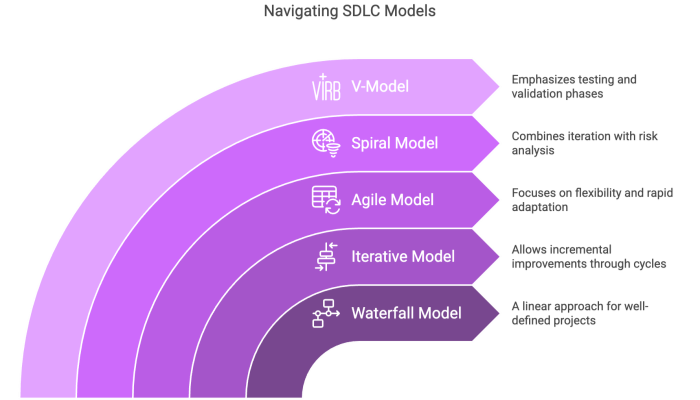

The 7 Phases of the Software Development Life Cycle
While SDLC models may vary, most organizations recognize a comprehensive 7‑phase approach that provides a full roadmap from idea inception to continuous improvement. This framework ensures that every critical aspect of development is addressed systematically, promoting quality and efficiency throughout the project’s lifespan. The seven phases include:
Phase 1: Planning
Purpose: Define scope, objectives, and feasibility of the project. During this phase, teams identify what the software should achieve, assess potential constraints, and determine resource availability.
Key Activities: These include setting high‑level requirements, conducting feasibility studies related to time, cost, and resources, and drafting initial project timelines along with success metrics. This phase results in a clear project charter that lays the groundwork for all subsequent phases.
Output: A comprehensive project charter, preliminary resource plans, and risk assessments that guide the development process.
Phase 2: Requirements Analysis
Purpose: Capture and document the precise needs for the solution. This phase is crucial for understanding both the functional and non‑functional requirements of the project.
Key Activities: Activities include gathering feedback from stakeholders through interviews, surveys, and user story workshops. Teams distinguish between functional requirements (such as features and tasks) and non‑functional needs (such as performance, security, and usability). The outcome is a detailed Software Requirements Specification (SRS) or a backlog of user stories for agile projects.
Output: Well‑documented requirements that have been validated by stakeholders, serving as a baseline for design and development.
Phase 3: Design
Purpose: Architect the solution and outline how to implement the gathered requirements. This phase transforms requirements into a tangible design that informs the coding process.
Key Activities: In the design phase, teams select the appropriate system architecture—be it client‑server, microservices, or a hybrid model. They choose the technology stack, including programming languages, frameworks, and databases, and develop UI mockups or wireframes to refine the user experience. Additionally, data models, class diagrams, and flowcharts are created to define the system’s logic and modules.
Output: A comprehensive Design Specification Document, accompanied by UI prototypes and architectural diagrams that serve as blueprints for development.
Phase 4: Coding
Purpose: Translate the design into a fully functional software solution by writing and integrating code.
Key Activities: This phase involves developing features as per the design specifications while adhering to best coding practices. Activities include code reviews, version control (using Git or similar systems), writing unit tests to validate functionality, and integrating external systems or APIs where necessary. Emphasis is placed on clean, maintainable code and robust documentation to support future iterations.
Output: A functional codebase that meets the design specifications, along with updated developer documentation and preliminary test results.
Phase 5: Testing
Purpose: Validate the software’s correctness, performance, and reliability before deployment.
Key Activities: Testing involves executing a range of test plans, including unit, integration, system, and acceptance tests. Teams identify and document defects or performance issues, and retest fixes through iterative cycles until the software meets predefined acceptance criteria. This phase is critical for ensuring that the final product is robust and free from critical errors.
Output: A thoroughly tested and defect‑resolved software product that aligns with the project’s quality standards.
Phase 6: Deployment
Purpose: Transition the software from a development environment to production, making it accessible to end users.
Key Activities: This phase includes preparing deployment scripts, configuring environments (or containers using Docker, Kubernetes), and performing final acceptance tests in a staging area. Deployment strategies such as big‑bang, blue‑green, or canary releases are employed to minimize risks. Additionally, user training or documentation may be provided to ensure smooth adoption.
Output: Live, operational software that is available to the target audience and meets all user acceptance criteria.
Phase 7: Maintenance
Purpose: Ensure that the software continues to function effectively, incorporates user feedback, and evolves with business needs over time.
Key Activities: Maintenance involves monitoring application performance through tools like APM and error logging, addressing bugs, and implementing minor enhancements or security patches. In addition, teams plan for major upgrades or new features based on evolving user requirements and market conditions.
Output: A stable and maintained software solution that continues to deliver value and adapts to changing business environments.
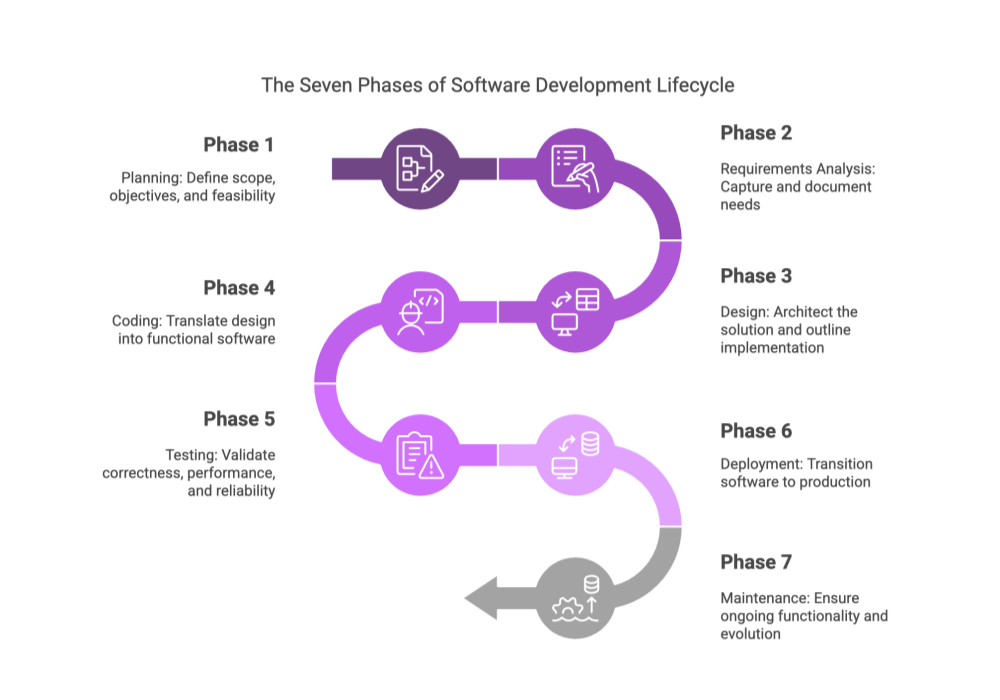

Choosing the Correct Order of SDLC Phases
In most implementations of the Software Development Life Cycle (SDLC), teams follow a linear sequence of seven phases:
- Planning: Establishing project scope and feasibility.
- Requirements Analysis: Gathering and documenting user needs.
- Design: Defining architecture and user interfaces.
- Coding (Implementation): Writing the code and building the core functionality.
- Testing: Verifying the software’s reliability and performance.
- Deployment: Releasing the product to the intended environment or end users.
- Maintenance: Supporting and evolving the software post-launch.
This structured order ensures that each step provides a checkpoint. Key documents (e.g., requirements, design specifications) guide the next phase, helping teams proceed in a logical manner. Whether an organization uses Waterfall, V-Model, or a similar plan-driven SDLC model, adhering to this sequence brings clarity to roles, responsibilities, and deliverables. By completing phases in order, development teams reduce oversights, minimize wasteful rework, and keep project objectives front and center.
Adapting the Sequence in Agile or Hybrid Models
While the standard progression is widely used, certain modern methodologies – particularly Agile and hybrid approaches – may merge or iterate through these phases multiple times:
- Frequent Iterations: In Scrum, for instance, mini-cycles incorporate planning, coding, and testing within each sprint (often 2-4 weeks). This repeated loop allows for continuous feedback and evolving requirements.
- Overlapping Workflows: Some teams adopt a continuous delivery pipeline, where coding, integration, and testing overlap, giving immediate feedback on new or updated features.
- Parallel Tracks: Larger organizations might split complex projects into sub-phases, with design and coding happening simultaneously across different modules. They still eventually converge for shared integration and testing efforts.
Regardless of whether you employ a strict sequential approach or an iterative model, each of the seven phases remains necessary in some capacity. Establishing a transparent flow – even when it’s repeated or abbreviated – helps ensure that no crucial step is left out and that each deliverable is validated before moving on to the next set of tasks.
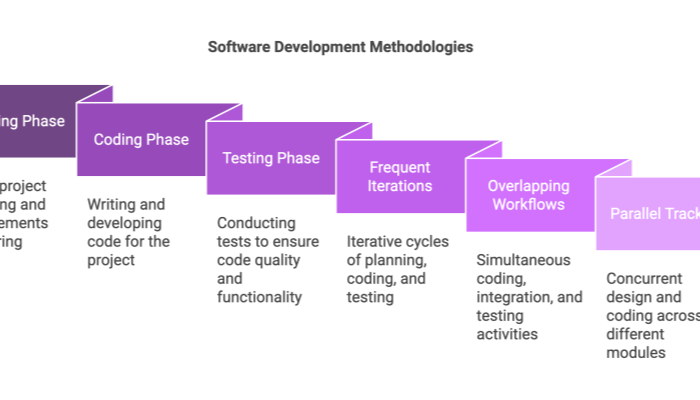

Automating SDLC Phases
Automation plays a critical role in modern software development by reducing manual tasks, minimizing errors, and speeding up feedback loops. Several phases of the SDLC lend themselves well to automation:
- Coding: Implementing Continuous Integration/Continuous Delivery (CI/CD) pipelines can automate the build process, code scanning, and even code reviews, ensuring that the codebase remains clean and secure.
- Testing: Automated test suites, including unit, integration, and performance tests, can quickly detect regressions and verify functionality, which leads to more reliable software.
- Deployment: Tools like Jenkins, Harness, and GitHub Actions allow for fully automated deployment processes, ensuring that releases are consistent and reproducible across environments.
In many organizations, testing and deployment are the most extensively automated phases, significantly reducing the time between iterations and ensuring continuous delivery of high‑quality software.
Adopting Best Practices for SDLC Automation
While automation tools and pipelines can yield tremendous gains in efficiency, implementing them effectively requires clear practices:
- Incremental Automation: Start with the highest-impact areas (often testing and deployment) before expanding to coding or security checks. This approach reduces the learning curve for teams new to automated processes.
- Clear Version Control Conventions: Standardize naming conventions, branching, and merging strategies to avoid confusion and ensure each automated job is triggered by correct code changes or pull requests.
- Continuous Monitoring and Feedback: Tools like dashboards or Slack notifications keep developers informed about build or deployment statuses, ensuring any failures are addressed quickly.
- Security-by-Design: Embed security scans—like static application security testing (SAST) or container vulnerability checks—into your automated pipeline, preventing later-stage disruptions.
By thoughtfully applying automation in the SDLC, organizations can compress release cycles, maintain high code quality, and achieve a more seamless developer experience across multiple phases of software creation.
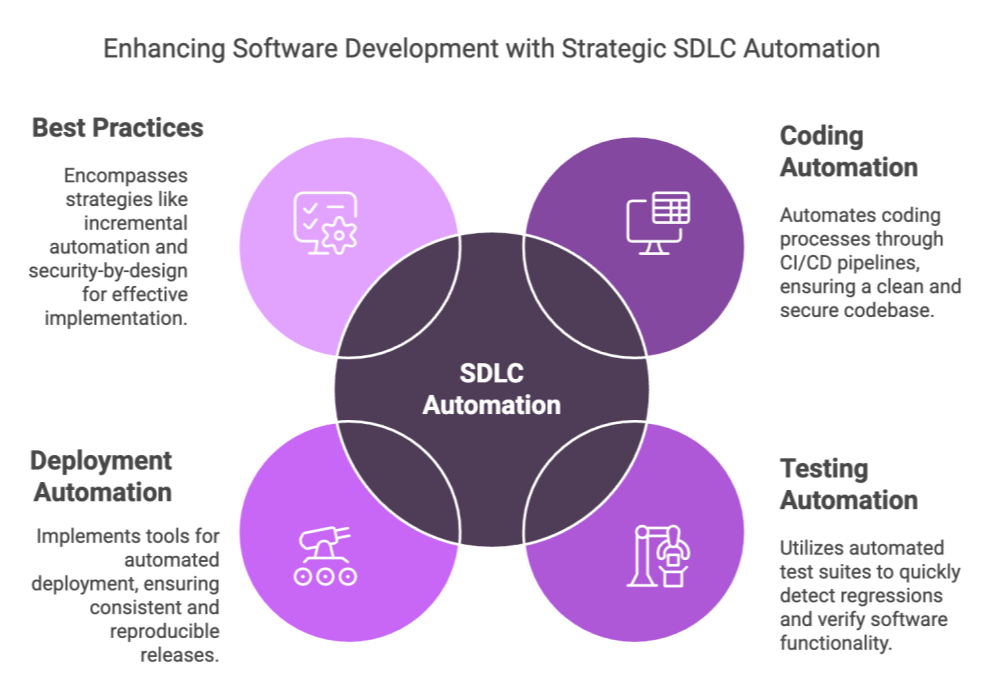

Frequently Asked Questions
Below are some common questions regarding the Software Development Life Cycle:
- What Are the Phases of the Software Development Life Cycle? – There are generally 7 phases: Planning, Requirements Analysis, Design, Coding (Implementation), Testing, Deployment, and Maintenance. Although different methodologies may use different labels or combine phases, these steps are fundamental.
- Which Phases Are Part of the SDLC? – The SDLC covers every step from the initial idea and planning through design, coding, testing, deployment, and ongoing maintenance to ensure the software remains robust and user‑centric.
- What Are the 5 Phases of the SDLC? – Some teams condense the SDLC into 5 phases by merging certain steps. For example, they might combine Requirements Analysis and Design or Deployment and Maintenance, while still covering all essential tasks.
- Why Is the SDLC Important? – The SDLC ensures that every aspect of software creation is methodically addressed. It organizes the process, fosters collaboration, manages risks, and helps produce high‑quality, user‑centric solutions efficiently.
- How Many Phases Are There in a Secure SDLC? – A secure SDLC includes additional security measures at each phase, such as threat modeling and penetration testing, but still generally follows the same 7‑phase structure.
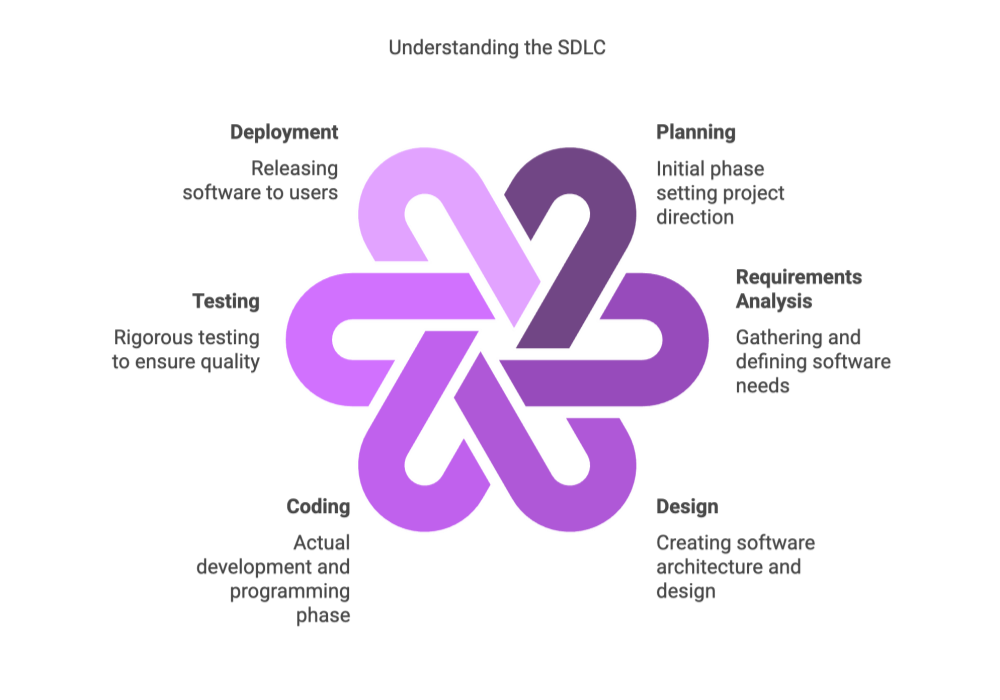

Conclusion
The Software Development Life Cycle provides a reliable, systematic roadmap that organizes concept ideation, planning, building, testing, deployment, and ongoing maintenance for a software application. By adhering to the seven phases—Planning, Requirements Analysis, Design, Coding, Testing, Deployment, and Maintenance—teams gain clarity on roles, deliverables, and how to incorporate user feedback effectively. This structured approach is key to producing high‑quality, user‑centric solutions that meet business objectives.
Whether you adopt agile, iterative, or a more traditional methodology, the SDLC ensures that the right features are developed at the right time, with quality and continuous improvement at its core. Advanced DevOps pipelines, automated testing, and cloud‑based CI/CD solutions further streamline this process, making it possible for software to evolve seamlessly from initial concept to long‑term sustainability.
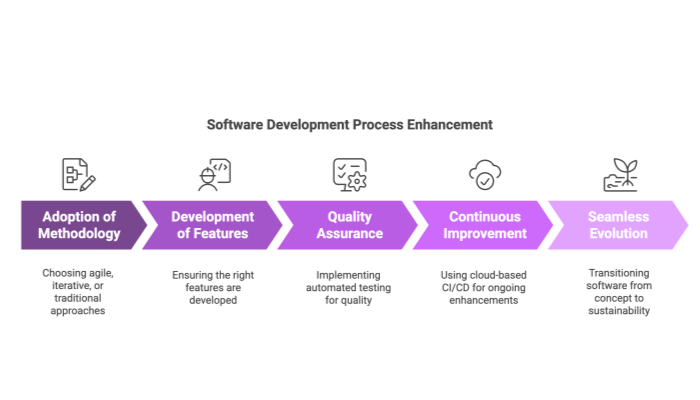

Get in Touch With Us
If you’re looking to streamline your software development process and implement a robust SDLC that ensures continuous improvement and high‑quality output, contact us today. Our expert team is here to help you integrate agile methodologies, automate testing, and build advanced CI/CD pipelines that deliver software aligned with your business objectives.

